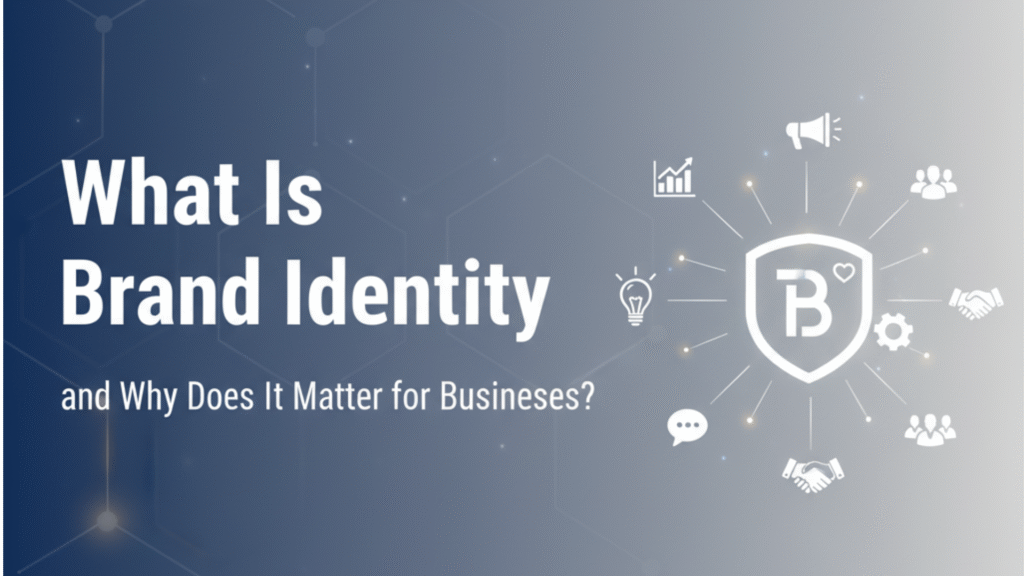What Is Brand Identity and Why Does It Matter for Businesses?

Introduction: Understanding the Significance of Brand Identity
In today’s saturated market, understanding what brand identity is and why it matters for businesses is crucial for success. This blog will delve into the essential components of brand identity, its significance across various industries—including restaurants and jewelry—and how it can dramatically influence customer perception and loyalty.
We will guide you through the key elements of effective and best branding, the stages of creating a cohesive brand identity, the importance of rebranding, and emerging trends that can keep your brand relevant. By the end of this article, you will have a comprehensive understanding of brand identity and its pivotal role in driving business growth.
1. Defining Brand Identity
What Exactly Is Brand Identity?
Brand identity is the collection of elements that a company uses to communicate what their brand stands for and how it wants to be perceived. The key components of brand identity include:
- Logo: A visual symbol that represents your brand.
- Color Palette: The colors chosen to convey emotions and values associated with your brand.
- Typography: The style of text that reflects your brand’s personality.
- Messaging: The communication style and tone, including slogans and taglines.
These elements work together to represent a business’s values, personality, and mission, ultimately shaping how customers perceive and engage with the brand.
2. The Importance of Brand Identity for Businesses
Why Does it Matter?
Strong brand identity can foster connection and loyalty among customers, prompting them to choose one brand over another. This is particularly crucial in competitive industries such as branding restaurants and branding jewelry, where consumers have numerous options available.
A well-defined brand identity distinguishes a business from its competitors, allowing it to carve out a unique position in the market. In crowded markets, consistent branding facilitates recognition, enabling customers to associate specific qualities and values with your business, whether it be sophistication in a jewelry brand or warmth in a family-owned restaurant.
3. The Impact of Brand Identity on Customer Perception
How Customers View Your Brand
The coherence of your brand identity significantly influences customer perception. When customers encounter a consistent and clear brand message across all touchpoints—such as advertising, social media, and in-store experiences—they develop a sense of trust and credibility towards your business.
Examples of businesses that have successfully embodied their brand identity can be seen in the restaurant and jewelry sectors. For instance, upscale dining establishments often employ luxurious visual branding to emphasize exclusivity, while artisanal jewelry brands may focus on storytelling to highlight craftsmanship and heritage.
4. Building a Strong Brand Identity
Steps for Creating a Cohesive Brand Identity
Creating a strong brand identity involves several key steps:
- Market Research: Understand your target audience’s preferences and behaviors.
- Brand Positioning: Define how your brand will fit into the market landscape.
- Messaging Development: Craft compelling and appealing messages that convey your brand’s ethos.
- Visual Identity: Choose a logo, color palette, and typography that represent your brand accurately.
- Consistency: Ensure that all brand representations (both visual and verbal) are consistent across all platforms.
Adopting best practices for visual identity—including the psychology of color and the significance of font styles—can amplify your ability to engage customers and communicate your brand values effectively.
5. Rebranding: When and Why It’s Necessary
Understanding the Rebranding Process
Sometimes businesses must undergo rebranding, which is the process of changing the public perception of a brand. This may be necessary due to shifts in target audience, marketing strategies, or core values. For example, a company looking to appeal to a younger demographic may benefit from a fresh brand identity.
Successful examples of rebranding include fast-food chains that have focused on healthier menu options or technology companies that have adopted sleeker and modern aesthetics. Such transformations can lead to revitalized customer interest and increased sales if done thoughtfully.
6. The Future of Brand Identity: Trends to Watch
Emerging Trends and Adaptations
As consumer preferences evolve, so too must brand identities. Key trends to watch include:
- Sustainability: More consumers are favoring brands that prioritize sustainable practices.
- Digital Transformation: With the rise of e-commerce, having a strong online brand presence has never been more critical.
- User-Generated Content: Encouraging your audience to share their experiences can enhance authenticity and connection.
Staying updated with these trends can help businesses maintain a relevant and impactful brand identity that resonates with consumers.
Conclusion: The Lasting Impact of Brand Identity
In summary, brand identity is a powerful tool for building customer trust and loyalty while differentiating your business in a competitive market. From the initial creation of your brand identity to the potential need for rebranding, every stage plays a crucial role in shaping your business’s future.
We invite you to share your thoughts and experiences regarding brand identity in the comments section below. Have you faced challenges or celebrated successes in branding? Your experiences could provide valuable insights for fellow readers navigating this essential aspect of business.




